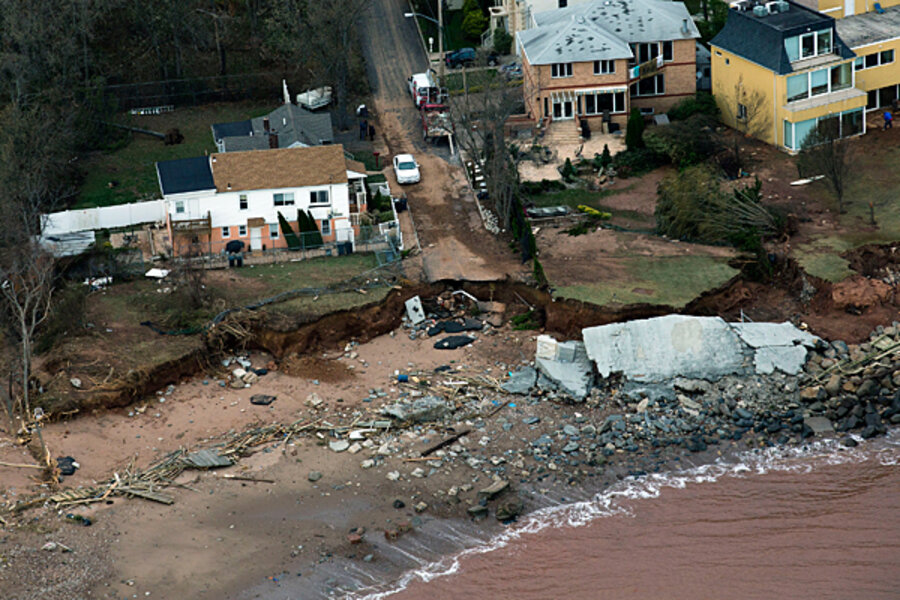Gov. Cuomo's grand plan post-Sandy: give some of New York back to nature
Loading...
Following through on his post-Sandy assessment that protecting New York state from coastal flooding would be a “massive undertaking,” Gov. Andrew Cuomo (D) is proposing the return of some flood-prone parcels of land to Mother Nature, spending $400 million to buy and demolish as many as 10,000 homes destroyed by the October superstorm.
Officials from Governor Cuomo’s office met with federal officials in Washington late Friday to present the ambitious hurricane recovery proposal, which would convert the purchased properties into an undeveloped buffer zone that would protect coastal communities from future storms.
The plan, which requires federal approval, would be funded in part from the $51 billion disaster relief package Congress approved in January, as well as from the federal Department of Housing and Urban Development, an agency Cuomo once headed.
In the wake of the Oct. 29 storm that damaged or destroyed more than 300,000 housing units in New York state, Cuomo has issued controversial warnings about climate change and has led efforts to find long-term solutions against future storms and floods.
“Climate change is a reality, extreme weather is a reality, it is a reality that we are vulnerable,” Cuomo said at a Sandy-recovery briefing in October. “Protecting this state from coastal flooding is a massive, massive undertaking. But it’s a conversation I think is overdue.”
In more recent speeches, Cuomo has suggested residents should abandon flood-prone areas. “There are some parcels that Mother Nature owns,” he said in his January State of the State address. “She may visit once every few years, but she owns the parcel and when she comes to visit, she visits.”
As part of his plan to return parcels of land to nature, Cuomo has proposed using federal and disaster relief funds to purchase and raze roughly 10,000 homes destroyed by Sandy in the 100-year floodplain, a zone that has a 1 percent chance each year of experiencing greater than normal flooding.
Under the proposal, the state would offer homeowners the pre-storm full market value of their house. Those in severe flood-prone areas would receive a 10 percent bonus above market value as an added incentive to sell. In extreme-risk areas, the state would offer an additional 10 percent bonus if every homeowner on a block signed up for the buyout.
Once under state ownership, the land would be turned into dunes, wetlands, parks, or other natural buffers that would offer protection against future storm surges, as per the discretion of local authorities. The land would not be built on again. Cuomo’s office said it predicts 10 to 15 percent of homeowners will pursue the buyout.
If the proposal is approved, the governor’s office has said it would announce additional details within the next two weeks.
The plan is one of many proposals – including dikes, a huge sea wall, and the re-introduction of oyster beds in New York Harbor – to find long-term solutions against future floods from storm surges.
Of course, local reaction to the governor’s proposal is mixed.
Councilman Vincent Ignizio (R), whose district includes storm-battered swaths of Staten Island, says residents in his district would welcome the buyout.
“Sometimes it’s more appropriate to look back and see if Mother Nature has won and allow people to be bought out of homes and moved to other parts of the community,” Councilman Ignizio says. “Staten Island seems to be the epicenter of interest for this program because they deal with a lot more than just flooding – a significant amount of forest fires, phragmites [an invasive grass that fuels wildfires], and overall flooding coming off the water on a regular basis.”
Ignizio cited the Oakwood Beach neighborhood on the eastern shore of Staten Island, where the majority of households – some 133 out of 165 – have said they would take a buyout offer.
“They’ve had it, they can’t go through another flooding, another wildfire or bailing out their basements, losing priceless keepsakes,” he says.
But many others are planning to dig in their heels, including those in New York State Senator Joseph Addabbo’s (D) district of more than 300,000, which includes Long Island’s vulnerable Rockaway Peninsula and Breezy Point.
“In his district he’s got people who have lived in these seaside homes for generations, these people who obviously stay there because they’ve got roots there,” says Judy Close, press secretary for Senator Addabbo.
“There’s a reason they live there – the water, they like it, and they’ve established close ties. They’re not easily influenced ... or easily scared by the storm that just happened,” she adds, “Folks have said, ‘We’re not going anywhere.’ They’re a pretty hardy group.”





